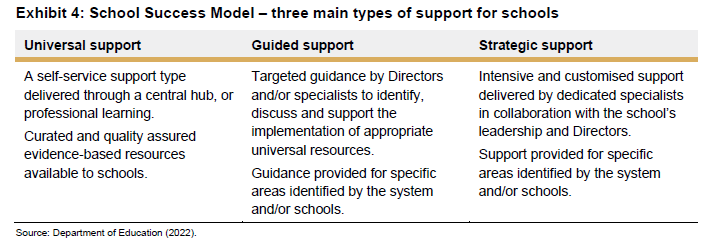Student attendance where to now?
Reflections on the New South Wales Auditor-General's Report 27 September 2022
We have known for some time that there are a significant number of young people who regularly miss school. According to the recent New South Wales Auditor-General's Report on school attendance (27 September 2022), in semester 1 of 2021, an alarming 30% of students were absent from school regularly. It was also found in 2021 that 35% of all department schools in NSW (775 of 2,200) had an average attendance rate below 90%.
If those figures are not cause for alarm, the department's preliminary data for 2022 alludes to an impending student absenteeism tsunami. It is forecast that student attendance for Semester 1, 2022 will fall further due to the ongoing impacts of COVID-related absences and natural disasters. An analysis of data within my own system attests to this with significantly lower levels of attendance compared to this time last year.
There has been much speculation as to why the significant lower levels of attendance now that schools are regularly open. Sticking with the tsunami metaphor, characteristically after the initial wave there is always a backwash that creates just as much havoc to systems already struggling. It is evident that floods, lack of permanent teaching staff and illness have all contributed to the depressed levels of attendance. I also see the messaging around school attendance has changed. Pre-COVID the message was that young people should only stay home if they are too sick to attend. However, post-COVID the message for parents has been to keep children home if they show any signs of being sick. Parents wanting to do the right thing are erring on the side of caution and keeping their children home.
It also cannot be ignored that many young people simply did not remain buoyant after COVID isolation. The elephant in the room is the significant impact COVID has had on young peoples’ mental health, connection and sense of belonging. By the end of 2021, 2950 students had not returned to school. At a recent international conference on school attendance it was suggested that the break in schooling through remote learning gave many young people a break from their anxiety attending school. Whilst a positive in the short term its effect in the long term has been to lower resilience and to heighten young peoples’ anxiety returning to school.
The availability of attendance data has shone light on the disturbing levels of specific groups of young people disengaging from education. In 2021, less than half (42.7%) of Aboriginal and Torres Strait Islander young people attended school regularly (not missing more than approximately 18 days a year). The figures for young people who live in remote schools are even more alarming with only 40.3% attending regularly.
What measures have been in place to support and address attendance?
Increase quality and access to attendance data
The importance of attendance data was high on the agenda of International Network for School Attendance (INSA) Conference last week. Prior to 2018 there was limited access to student level data. It’s clear that without accurate and timely attendance data it is impossible for schools and systems to support attendance and address school attendance problems. As many writers point out - attendance problems are pernicious, in that they are problems hidden in plain sight, only visible through the availability of data.
Having data is only the first step. Schools and teachers do not have time nor the skill to analyse attendance data. It is important that systems provide schools and teachers with tools such as data visualisations that present clear findings so that they may be acted upon promptly. Schools also need training in responding to the attendance data within Multi Dimensional Multi- tiered Systems of Support (MTSS).
Setting targets
Foundational to change and continual improvement is the setting of targets. It is evident in the New South Wales Auditor-General's Report on school attendance that target setting has had the effect of raising awareness towards attendance. However, it appears bureaucracy has thwarted efforts to make inroads. To counter the short timeframe afforded to schools to meet targets the department decided to focus resources and programs on those students already close to the 90% benchmark. Schools interviewed as part of the review reported that they were less likely to give focus to attendance targets that were deemed to be unachievable.
This does raise questions regarding approach towards attendance problems. It is suggested through the department’s approach that addressing students with an emerging attendance problem in a large school would have most impact. My position is that this is very short sighted, ignores equity and does not account for the complexity of school attendance and engagement. There is also a significant human cost (see Guardian 26/09/2022) when the most vulnerable students do not receive the support they need. If significant inroads are to be made targets should be developed with all students in mind not just some.
Home school Liaison Program
The Home School Liaison Program has the potential to make a difference in the lives of those young people with the greatest need. It is evident that more evaluation and research is needed as to the best approach in providing this service. Essentially, when a school has serious concerns about a student's attendance, they can request assistance from the Home School Liaison Program. It is suggested from the description in the Auditor General’s Report of the service provided that there is limited scope for therapeutic support within this service.
This program aims to address the factors preventing attendance through escalating interventions that can involve legal action if attendance is not restored following all reasonable efforts.
The HSLO/ASLO and the school will monitor the student's compliance with their attendance plan. Students who show improved attendance in the first weeks of the program can be removed from support. If the student's attendance declines again, the school must re-try school-level strategies before re-applying for support.
There is ample evidence to support that legal and adversarial measures alone are ineffective at addressing school attendance problems.
The department referred 2,313 cases to the courts between January 2018 and May 2021. Of these cases, around 5.6% resulted in fines being issued.
Whilst they can bring parents and young people to the table to discuss the issues, on their own they rarely provide deep understanding or solutions. Instead the goal of the Home School Liaison program should be to walk alongside the parents and providing support.
Embedding a Multi Dimensional Multi- tiered System of Supports across the System and Schools
The Auditor-General's Report advocates for evidence based decision making and graduated levels of support. However, there is no reference to the department steering towards Multi- Tiered System of supports to support the use of evidence in decision making. At present there is a graduated three tiered support structure across the department under the School Success Model (see below). A review of the Universal Support resources finds that they are comprehensive. In my view they allow schools to manage attendance through administrative support structures. To improve the resources it is recommended that a broader scope be applied to include more professional learning on school refusal and childhood mental health problems. Whilst this does provide a basis for evidenced based decision making a more nuanced approach may enhance schools capacity to tackle attendance problems.
Supporting Aboriginal Students’ Attendance
A significant program of change both within schools and communities is needed to address the alarming disengagement of Aboriginal young people. In 2021, 42.7% of Aboriginal students attended school regularly. There has been a steady decline in the levels of Aboriginal students attending since 2018. The Connected Communities strategy was launched in 2012, aiming to address the educational and social disadvantage experienced by Aboriginal young people living in a number of complex and disadvantaged communities. A review of the program in 202 found attendance rates fell by an average of 5.6 percentage points in the 31 Connected Community schools across the State. Outside of the 31 Connected Communities schools and 26 Aboriginal Student Liaison Officers across the State, there is no specific strategy to address the gap in attendance rates for Aboriginal students.
Where to now?
It is evident that there is considerable work to be done to re-engage young people and support the most vulnerable members of school communities. The Auditor-General's Report makes 9 recommendations. The most pressing in my opinion are:
Recommendation 3 - Evaluate the Universal, Guided and Strategic attendance support resources and programs to asses impact, identify potential gaps and improve on existing resources.
In my view the department should take this as an opportunity to embed a Multi- Tiered System of support approach incorporating data analysis and a nuanced graduating of supports from universal through to strategic support.
Recommendation 7 - Review the approach to enforcing compulsory school attendance, including: the adequacy of the home school liaison program resources; the appropriateness of reporting lined and links with other central support positions; the program costs and long term outcomes and the relative effectiveness compared to early intervention approaches.
It is agreed that more transparency is needed into the effectiveness of the home school liaison program’s effectiveness. The program serves the essential role of meeting the needs of those who present with acute school attendance problems. It is evident in the departments response that it is viewed as the legal arm of the departments attendance support process.
Experience tells us that we need to be careful what measures we place on evaluating effectiveness. The complexity of issues faced by young people with school attendance problems often means school is secondary to addressing pressing mental health and wellbeing needs. I would hate to see a scaling back of the home school liaison program in favour of resourcing supports for students who present with emerging attendance problems.






